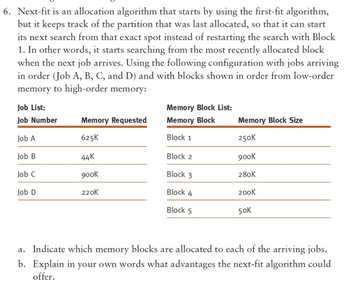
Database System Concepts
7th Edition
ISBN: 9780078022159
Author: Abraham Silberschatz Professor, Henry F. Korth, S. Sudarshan
Publisher: McGraw-Hill Education
expand_more
expand_more
format_list_bulleted
Concept explainers
Question

Transcribed Image Text:6. Next-fit is an allocation algorithm that starts by using the first-fit algorithm,
but it keeps track of the partition that was last allocated, so that it can start
its next search from that exact spot instead of restarting the search with Block
1. In other words, it starts searching from the most recently allocated block
when the next job arrives. Using the following configuration with jobs arriving
in order (Job A, B, C, and D) and with blocks shown in order from low-order
memory to high-order memory:
Job List:
Job Number
Job A
Job B
Job C
Job D
Memory Requested
625K
44K
900K
220K
Memory Block List:
Memory Block
Block 1
Block 2
Block 3
Block 4
Block 5
Memory Block Size
250K
900K
280K
200K
50K
a. Indicate which memory blocks are allocated to each of the arriving jobs.
b. Explain in your own words what advantages the next-fit algorithm could
offer.
Expert Solution
This question has been solved!
Explore an expertly crafted, step-by-step solution for a thorough understanding of key concepts.
This is a popular solution
Trending nowThis is a popular solution!
Step by stepSolved in 2 steps with 1 images

Knowledge Booster
Learn more about
Need a deep-dive on the concept behind this application? Look no further. Learn more about this topic, computer-science and related others by exploring similar questions and additional content below.Similar questions
- JAVA Task, by using ArrayList The program reads manatee names from the standard input stream and from time to time prints a sorted portion of the list of names. All the manatee names in the input are given in the order in which the necropsy was performed. You can imagine a unique timestamp associated with each necropsy. The names are not necessarily unique (many of the manatees have the same name). Interspered in the standard input stream are queries that begin with the question mark character. Queries ask for an alphabetical list of manatee names to be printed to the standard output stream. The list depends only on the names upto that point in the input stream and does include any manatee names that appear in the input stream after the query. The list does not contain all the names of the previous necropsies, but only a selection of them. A query provides the names of two manatees, say A and B. The response to the query drops necropsies performed before the first named A and all the…arrow_forwardHow will this project be solved in Python? Thanks. There are example outputs in the picture.arrow_forwardIn the third step, you will review the Quicksort and the Insertion Sort code. You will recall from the class presentation that it was suggested that Quicksort is not very efficient when the partition sizes become very small. It was also suggested in class that most implementations of Quicksort switch to another method when the partition size gets small. Create a new version of the Quicksort code to switch to Insertion sort on partitions less than 32 data items in size. 1. Confirm, using a small data set, that your version works. 2. Run a comparison between the original Quicksort and your new version in a way like the way you did comparisons in Step 2. Use the RANDOM.TXT file for the data to test both versions - with at least 50000 items of data in your input file.arrow_forward
Recommended textbooks for you
 Database System ConceptsComputer ScienceISBN:9780078022159Author:Abraham Silberschatz Professor, Henry F. Korth, S. SudarshanPublisher:McGraw-Hill Education
Database System ConceptsComputer ScienceISBN:9780078022159Author:Abraham Silberschatz Professor, Henry F. Korth, S. SudarshanPublisher:McGraw-Hill Education Starting Out with Python (4th Edition)Computer ScienceISBN:9780134444321Author:Tony GaddisPublisher:PEARSON
Starting Out with Python (4th Edition)Computer ScienceISBN:9780134444321Author:Tony GaddisPublisher:PEARSON Digital Fundamentals (11th Edition)Computer ScienceISBN:9780132737968Author:Thomas L. FloydPublisher:PEARSON
Digital Fundamentals (11th Edition)Computer ScienceISBN:9780132737968Author:Thomas L. FloydPublisher:PEARSON C How to Program (8th Edition)Computer ScienceISBN:9780133976892Author:Paul J. Deitel, Harvey DeitelPublisher:PEARSON
C How to Program (8th Edition)Computer ScienceISBN:9780133976892Author:Paul J. Deitel, Harvey DeitelPublisher:PEARSON Database Systems: Design, Implementation, & Manag...Computer ScienceISBN:9781337627900Author:Carlos Coronel, Steven MorrisPublisher:Cengage Learning
Database Systems: Design, Implementation, & Manag...Computer ScienceISBN:9781337627900Author:Carlos Coronel, Steven MorrisPublisher:Cengage Learning Programmable Logic ControllersComputer ScienceISBN:9780073373843Author:Frank D. PetruzellaPublisher:McGraw-Hill Education
Programmable Logic ControllersComputer ScienceISBN:9780073373843Author:Frank D. PetruzellaPublisher:McGraw-Hill Education

Database System Concepts
Computer Science
ISBN:9780078022159
Author:Abraham Silberschatz Professor, Henry F. Korth, S. Sudarshan
Publisher:McGraw-Hill Education

Starting Out with Python (4th Edition)
Computer Science
ISBN:9780134444321
Author:Tony Gaddis
Publisher:PEARSON

Digital Fundamentals (11th Edition)
Computer Science
ISBN:9780132737968
Author:Thomas L. Floyd
Publisher:PEARSON

C How to Program (8th Edition)
Computer Science
ISBN:9780133976892
Author:Paul J. Deitel, Harvey Deitel
Publisher:PEARSON

Database Systems: Design, Implementation, & Manag...
Computer Science
ISBN:9781337627900
Author:Carlos Coronel, Steven Morris
Publisher:Cengage Learning

Programmable Logic Controllers
Computer Science
ISBN:9780073373843
Author:Frank D. Petruzella
Publisher:McGraw-Hill Education